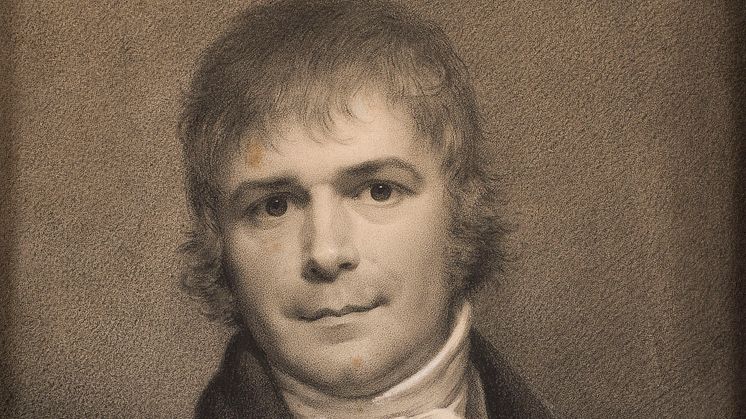
Press release -
Nationalmuseum acquires self-portrait by Lié-Louis Périn-Salbreux
Nationalmuseum has acquired a self-portrait by Lié-Louis Périn-Salbreux, a French miniaturist. The piece is one of the artist’s later works and, unlike many of his other self-portraits, is unusually modest and largely free from affectation. Périn was heavily influenced by the Swedish artist Peter Adolf Hall and enjoyed his greatest success during the years immediately before and after the French Revolution.
Lié-Louis Périn-Salbreux (1753–1817) was born in Reims, the son of a wool manufacturer. At the age of 19, he arrived in Paris to be a pupil in the studio of Jean-Baptiste Vien. By the following year, 1773, he had already been admitted to the academy of fine arts as a student, as Vien was the academy’s director. There, Périn encountered other influential artists, including Alexander Roslin, the Swedish-born portrait painter. His friendship with Roslin was to prove crucial to his future success, giving him access to several high-ranking clients, including members of the royal family, of whom Périn painted small, intimate portraits in oils. But it was as a miniature portraitist that Périn was to make his name. His training in this art form was acquired privately rather than at the academy, and the best-known of his teachers was Louis Marie Sicardi.
Roslin was generous with his support, not only referring clients but also commissioning Périn to paint portraits of Roslin himself and his wife, Marie Suzanne Giroust, which are now in the Nationalmuseum collection. The miniaturist also painted other family members, including Roslin’s daughter-in-law Adélaïde and grandson Abraham – a portrait acquired by Nationalmuseum fairly recently. What was more, Roslin entrusted Périn with creating miniature replicas of Roslin’s own oil portraits. Quite frequently, clients simply wanted a reduced version of their existing portrait, and it fell to Roslin’s younger colleague to carry out the job. One such example is a miniature replica of Roslin’s pastel portrait of the ill-fated Crown Prince Louis. Throughout the 1780s, Périn enjoyed a productive and successful career as a miniaturist without being elected to the academy. When the art world became more democratic during the Revolutionary period, he was able to exhibit at the Salon for eight years from 1791.
Périn soon adopted the free style of Swedish miniaturist Peter Adolf Hall, with its vibrating brushwork, and through Roslin he made direct contact with Hall. Like Hall, Périn employed elegant accents in the form of clothing and draperies. Both also liked to place their models in natural or parkland settings. However, Périn’s depiction of the models’ faces was more affected, with distinctive, almond-shaped eyes. Like Hall, Périn suffered when his wealthy clients emigrated during the French Revolution. As a result of monetary depreciation, Périn lost his capital and left Paris in 1799 to take charge of his family’s woollen mill in Reims. The newly married artist appended his wife’s maiden surname, Salbreux, to his own. Back in his hometown, he continued working as a portraitist, but mainly in oils and pastels. Hence his choice of technique for the self-portrait in black crayon, drawn sometime between 1800 and 1810, which was recently acquired by Nationalmuseum. Over many years, Périn produced self-portraits using various techniques, both in oils and in miniature format. These were often somewhat pretentious, indicating that the artist had a good conceit of himself, but in this relatively late work he takes a more restrained approach. The image is drawn with fine gradations in black crayon, stumped with elevations in white. Given the palpably graphic nature of the work, it is not surprising that it later provided the basis for an engraving by Henri-Joseph Dubouchet, many years after Périn’s death.
“In this sensitive self-portrait by Lié-Louis Périn-Salbreux, we see an artist with no great pretensions, with a gentle, understanding expression. This new acquisition joins Nationalmuseum’s collection of self-portraits by miniaturists, which is the only one of its kind in the world. So we are delighted to put this significant artwork on display in the Treasury,” said Magnus Olausson, director of collections.
Nationalmuseum receives no state funds with which to acquire design, applied art and artwork; instead the collections are enriched through donations and gifts from private foundations and trusts. This acquisition has been made possible by a generous donation from the Hjalmar and Anna Wicander Foundation.
Inventory number
Louis-Lié Périn-Salbreux, Self-Portrait. Black crayon, stumped and elevated with white crayon, on paper. NMB 2819.
Media enquiries
Magnus Olausson, director of collections, magnus.olausson@nationalmuseum.se, +46 8 5195 4371
Hanna Tottmar, head of press, press@nationalmuseum.se, +46 8 5195 4400
Categories
Nationalmuseum is Sweden’s museum of art and design. The collections comprise some 700 000 objects, including paintings, sculpture, drawings and graphic art from the 16th century up to the beginning of the 20th century and the collection of applied art and design up to the present day. Nationalmuseum is a government authority with a mandate to preserve cultural heritage and promote art, interest in art and knowledge of art.

